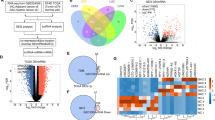Abstract
STAT3 is an oncogene which mainly capable of regulating various biological characters by its transcriptional factor features driving thousands of genes. However, its upstream noncoding RNA-related regulations still remain unknown. In this study, we focused on the microRNA (miRNA)-associated single nucleotide polymorphisms (SNPs) in the 3′ unstranslated region (UTR) of STAT3 to investigate the further relationship of the SNPs with miRNAs among Chinese patients with hepatocellular carcinoma (HCC). We found that patients suffering from HBV infection indicated to be the susceptible population by comparing with controls. Besides, SNP rs111904020 (U/G) in STAT3, 3′UTR was involved in the occurrence of HCC by acting as tumor promoter factors. SNP rs111904020 (U/G) could be regulated by miR-214 which caused an upregulation of STAT3. Furthermore, the carriers of G genotype was related to high expression of STAT3, and larger tumor size as well as high probability of metastasis. Moreover, the SNP of U/G was associated with poor survival and high reoccurrence of HCC with a 5-year follow-up study. In conclusion, our findings have shown that the SNP rs111904020 (U/G) in STAT3 3′UTR acted as promotion factors in the HCC development through disrupting the regulatory role of miR-214 in STAT3 expression.


Similar content being viewed by others
References
Abbas Z, Abbas M, Abbas S, Shazi L. Hepatitis D and hepatocellular carcinoma. World J Hepatol. 2015;7(5):777–86. doi:10.4254/wjh.v7.i5.777.
Li L, Wang H. Heterogeneity of liver cancer and personalized therapy. Cancer Lett. 2015. doi:10.1016/j.canlet.2015.07.018.
Banerjee K, Resat H. Constitutive activation of STAT3 in breast cancer cells: a review. International journal of cancer Journal international du cancer. 2015. doi:10.1002/ijc.29923.
Vogel TP, Milner JD, Cooper MA. The ying and yang of STAT3 in human disease. J Clin Immunol. 2015;35(7):615–23. doi:10.1007/s10875-015-0187-8.
Buonaguro L, Tagliamonte M, Petrizzo A, Damiano E, Tornesello ML, Buonaguro FM. Cellular prognostic markers in hepatocellular carcinoma. Future Oncol. 2015;11(11):1591–8. doi:10.2217/fon.15.39.
Cao Q, Li YY, He WF, Zhang ZZ, Zhou Q, Liu X, et al. Interplay between microRNAs and the STAT3 signaling pathway in human cancers. Physiol Genomics. 2013;45(24):1206–14. doi:10.1152/physiolgenomics.00122.2013.
Hatziapostolou M, Polytarchou C, Aggelidou E, Drakaki A, Poultsides GA, Jaeger SA, et al. An HNF4alpha-miRNA inflammatory feedback circuit regulates hepatocellular oncogenesis. Cell. 2011;147(6):1233–47. doi:10.1016/j.cell.2011.10.043.
Schwabe RF, Wang TC. Targeting liver cancer: first steps toward a miRacle? Cancer Cell. 2011;20(6):698–9. doi:10.1016/j.ccr.2011.11.021.
Tomimaru Y, Eguchi H, Nagano H, Wada H, Tomokuni A, Kobayashi S, et al. MicroRNA-21 induces resistance to the anti-tumour effect of interferon-alpha/5-fluorouracil in hepatocellular carcinoma cells. Br J Cancer. 2010;103(10):1617–26. doi:10.1038/sj.bjc.6605958.
Zhang Y, Wei W, Cheng N, Wang K, Li B, Jiang X, et al. Hepatitis C virus-induced up-regulation of microRNA-155 promotes hepatocarcinogenesis by activating Wnt signaling. Hepatology. 2012;56(5):1631–40. doi:10.1002/hep.25849.
Wang B, Hsu SH, Majumder S, Kutay H, Huang W, Jacob ST, et al. TGFbeta-mediated upregulation of hepatic miR-181b promotes hepatocarcinogenesis by targeting TIMP3. Oncogene. 2010;29(12):1787–97. doi:10.1038/onc.2009.468.
Sentinelli F, Filippi E, Fallarino M, Romeo S, Fanelli M, Buzzetti R, et al. The 3′-UTR C>T polymorphism of the oxidized LDL-receptor 1 (OLR1) gene does not associate with coronary artery disease in Italian CAD patients or with the severity of coronary disease. Nutrition, metabolism, and cardiovascular diseases: NMCD. 2006;16(5):345–52. doi:10.1016/j.numecd.2005.06.002.
Furtek SL, Backos DS, Matheson CJ, Reigan P. Strategies and approaches of targeting STAT3 for cancer treatment. ACS Chem Biol. 2016. doi:10.1021/acschembio.5b00945.
GoDarts, Group UDPS, Wellcome Trust Case Control C, Zhou K, Bellenguez C, Spencer CC, et al. Common variants near ATM are associated with glycemic response to metformin in type 2 diabetes. Nat Genet. 2011;43(2):117–20. doi:10.1038/ng.735.
Bruserud O, Nepstad I, Hauge M, Hatfield KJ, Reikvam H. STAT3 as a possible therapeutic target in human malignancies: lessons from acute myeloid leukemia. Expert Rev Hematol. 2015;8(1):29–41. doi:10.1586/17474086.2015.971005.
Hamamoto R, Saloura V, Nakamura Y. Critical roles of non-histone protein lysine methylation in human tumorigenesis. Nat Rev Cancer. 2015;15(2):110–24. doi:10.1038/nrc3884.
Buchert M, Burns CJ, Ernst M. Targeting JAK kinase in solid tumors: emerging opportunities and challenges. Oncogene. 2015. doi:10.1038/onc.2015.150.
Dutta P, Sabri N, Li J, Li WX. Role of STAT3 in lung cancer. Jak-Stat. 2014;3(4):e999503. doi:10.1080/21623996.2014.999503.
Oh EC, Vasanth S, Katsanis N. Metabolic regulation and energy homeostasis through the primary cilium. Cell Metab. 2015;21(1):21–31. doi:10.1016/j.cmet.2014.11.019.
Deguchi A. Curcumin targets in inflammation and cancer. Endocrine, metabolic & immune disorders drug targets. 2015;15(2):88–96.
Rybak AP, Bristow RG, Kapoor A. Prostate cancer stem cells: deciphering the origins and pathways involved in prostate tumorigenesis and aggression. Oncotarget. 2015;6(4):1900–19.
Shih TC, Tien YJ, Wen CJ, Yeh TS, Yu MC, Huang CH, et al. MicroRNA-214 downregulation contributes to tumor angiogenesis by inducing secretion of the hepatoma-derived growth factor in human hepatoma. J Hepatol. 2012;57(3):584–91. doi:10.1016/j.jhep.2012.04.031.
Xia H, Ooi LL, Hui KM. MiR-214 targets beta-catenin pathway to suppress invasion, stem-like traits and recurrence of human hepatocellular carcinoma. PLoS One. 2012;7(9):e44206. doi:10.1371/journal.pone.0044206.
Author information
Authors and Affiliations
Corresponding author
Ethics declarations
All participants have provided their written informed consents to participate in this study. This study was approved by the institutional Review Board of the first affiliated hospital to Nanjing Medical University.
Conflicts of interest
None
Rights and permissions
About this article
Cite this article
Fan, Y., Qian, X. & Zhang, C. U/G SNP rs111904020 in 3′UTR of STAT3 regulated by miR-214 promotes hepatocellular carcinoma development in Chinese population. Tumor Biol. 37, 14629–14635 (2016). https://doi.org/10.1007/s13277-016-5352-z
Received:
Accepted:
Published:
Issue Date:
DOI: https://doi.org/10.1007/s13277-016-5352-z




